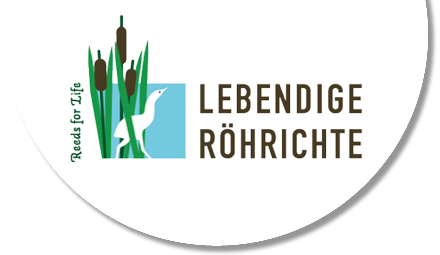Nature Conservation Goals
Implementation of the measures planned in the project aims to extend the reeds and floating leaf vegetation and, associated with this, to markedly improve the quality of the Flora + Fauna habitat type “natural eutrophic lakes and oxbow lakes”.
Additionally, the Flora + Fauna habitat “Rivers with muddy banks with Chenopodion rubri p.p. and Bidention p.p. vegetation” should develop, primarily through dynamisation of the water level. This entertaining habitat with annual vegetation can develop when bank areas become dry in the summer or late summer.
The water and reed birds should benefit from the habitat improvements. Particular attention is paid to the species that are endangered, or even at risk of extinction, both in NRW and in Germany as a whole: shoveller (Anas clypeata), common teal (Anas crecca), garganey (Anas querquedula), common pochard (Aythya ferina), common snipe (Gallinago gallinago), bluethroat (Luscinia svecica) and water rail (Rallus aquaticus). Their populations should grow and their conservation status in the “Lower Rhine” bird protection area should improve or the species should return. What all of these species have in common is that reeds and shallow water zones, and sometimes also mud areas, are essential elements of their breeding habitat. The same also applies to the reed warbler (Acrocephalus scirpaceus) and the marsh harrier (Circus aeruginosus). Although the reed warbler has a good conservation status both in NRW and in the project area, the population should be secured and increased by the measure.
Particular target species also include the black tern (Chlidonias niger) and bittern (Botaurus stellaris), whose presence indicates intact floodplains. The black tern has one of its last breeding sites in NRW in the project area. The black tern population is to be conserved and encouraged. The planned measures have the aim of making natural breeding possible again so that artificial nesting aids are no longer necessary. The bittern should return to the project area if possible.
Furthermore, it is possible that various species that used to breed on the Bienen Old Rhine, great reed warbler (Acrocephalus arundinaceus), sedge warbler (Acrocephalus schoenobaenus) and spotted crake (Porzana porzana) will return.
In addition to the birds, the focus is on another endangered animal species, i.e. the bitterling (Rhodeus amarus), which is also highly endangered in Germany. This Annex II fish species still enjoys a favourable conservation status in the project area. This should be secured. The bitterling will be supported in many ways by the project. Since it settles in vegetation-rich bank zones, the development of reeds will optimise and enlarge its habitat. The aeration of the sediment by the reeds and the improvement development opportunities for the zooplankton also increase the food available to it. For reproduction, the bitterling depends on mussels in the gill space of which it lays its spawn. Removing the coypu reduces the predator pressure from these mussels. It is known that coypu are fond of mussels as well as plants.
Habitat type
The European natural habitat types are natural habitats which are considered to be of European interest. They are listed in Annex I "European Union Habitats" of the Habitats Directive and therefore need to be considered in the NATURA 2000 network. That means that special protected areas have to be designated for their conservation.
Amongst them are common and large habitats as well as small and rare ones.
For Germany 92 habitat types are listed.







